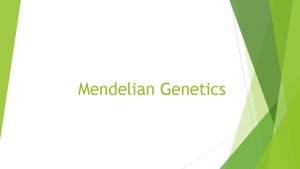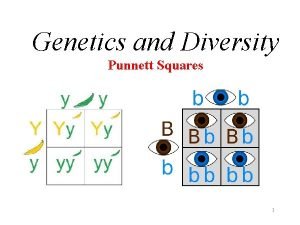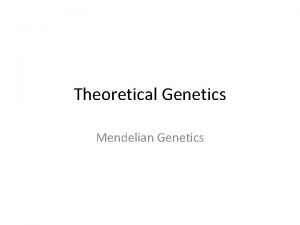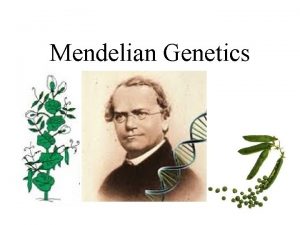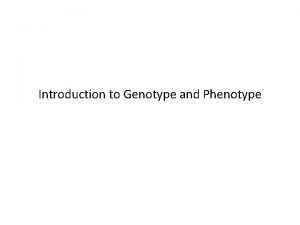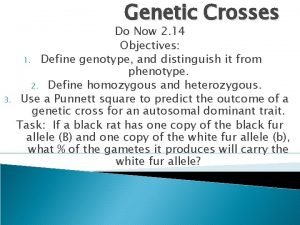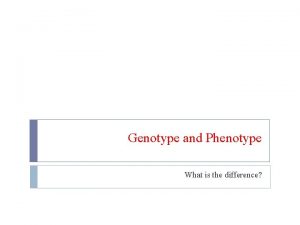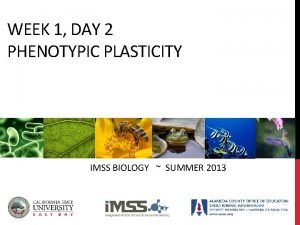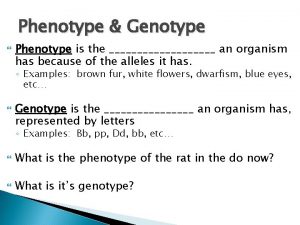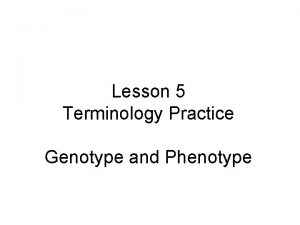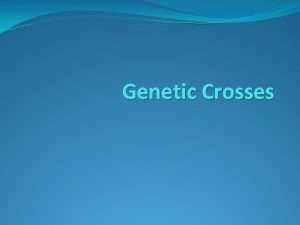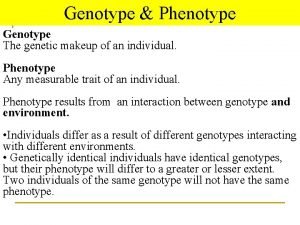Phenotype Genotype Phenotype is the characteristic an organism










- Slides: 10

Phenotype & Genotype Phenotype is the characteristic an organism has because of the alleles it has. ◦ Examples: brown fur, white flowers, dwarfism, blue eyes, etc… Genotype is the different alleles an organism has, represented by letters ◦ Examples: Bb, pp, Dd, bb, etc… What is the phenotype of the fnords in the do now? What is it’s genotype?

Heterozygous & Homozygous The genotype of an organism can be heterozygous or homozygous Heterozygous individuals have two different alleles for a gene – like the rat in the do now. (Hetero = different) ◦ Example: Bb = one brown eye allele, one blue eye allele Homozygous individuals have two of the same allele. (Homo = same) ◦ Example: BB, bb, PP, pp, etc…

Dominant & Recessive alleles: The relationship of Genotype & Phenotype Since a homozygous individual has two identical alleles, their phenotype will be whatever those alleles are ◦ Genotype = BB; Phenotype = brown eyes ◦ Genotype = bb; Phenotype = blue eyes A heterozygous individual will have the dominant trait. A dominant allele is one that masks or hides the presence of a recessive one. ◦ Genotype = Bb; Phenotype = brown eyes ◦ Brown eye allele (B) is dominant to blue eye allele (b)

Type of Inheritance #1: Autosomal Dominance If a gene is autosomal dominant: ◦ The gene is located on an autosome, so all diploids have 2 copies. ◦ One allele is dominant to the recessive version, giving homozygous dominant and heterozygous individuals the same phenotype ◦ Example: tongue rolling in humans TT = tongue roller Tt = tongue roller tt = no tongue roller

Practice In cows, having spots (S) is dominant to no spots (s) ◦ ◦ ◦ What is the phenotype of a cow that has spots? What is the genotype of a heterozygous cow? Will a heterozygous cow have spots? What is the genotype of a cow with no spots? If a cow has spots, what 2 genotypes might it have?

More Practice In pea plants, yellow seed color (Y) is dominant to green seed color (y). ◦ ◦ ◦ What is the genotype of a plant with green seeds? What is the phenotype of a Yy plant? Is a YY plant homozygous or heterozygous? Is a yy plant homozygous or heterozygous? If a YY plant self-fertilizes, what color will the seeds of its offspring be?

Punnett Square A diagram that helps predict the outcome of a genetic cross. The offspring produced by a genetic cross are described in two ways: ◦ Phenotype ratio: the ratio of one phenotype to the other. ◦ Example: 2 black rats, 2 white rats = 1: 1 phenotype ratio ◦ Genotype ratio: the ratio of all of the different genotypes of the offspring ◦ Example: 1 BB, 2 Bb, 1 bb = 1: 2: 1 genotype ratio

Monohybrid Cross Step 1: draw a 2 x 2 square Step 2: put the possible alleles from parent number one on top of the two squares Step 3: put the possible alleles from parent number 2 on the left Step 4: Write the alleles at top down the column, and the alleles at left across the row Step 5: Check

Genetic Crosses Yy YY Yy Y y yy x Yy 3: 1 1: 2: 1

Practice The example problems on your worksheet will let you know if you’ve picked up the skills you need to be a future geneticist! Work on them now, so that I can help before you go. Add “Punnett square worksheet” to your syllabus for homework.
 What is the phenotype of the mother having bbnn genotype
What is the phenotype of the mother having bbnn genotype Brown eyed father blue eyed mother
Brown eyed father blue eyed mother Mendel
Mendel Genotypic ratio of monohybrid cross
Genotypic ratio of monohybrid cross Law of segregation meiosis
Law of segregation meiosis Phenotype and genotype
Phenotype and genotype Genotype
Genotype Phenotype example
Phenotype example What is the difference between phenotype and genotype
What is the difference between phenotype and genotype Genotype and phenotype examples punnett square
Genotype and phenotype examples punnett square Phenotype, genotype
Phenotype, genotype
